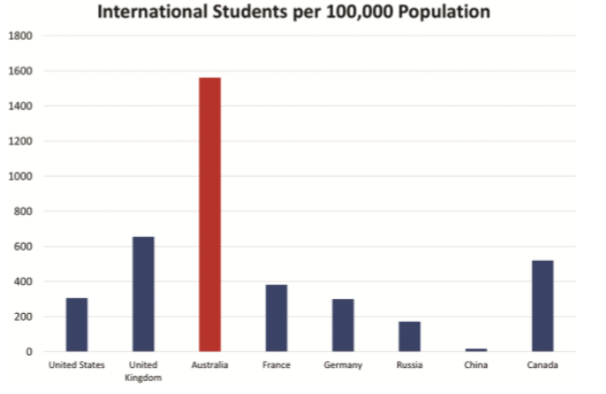Nancy Arthur – Dean of Research at UniSA Business – has penned a scaremongering article in The Conversation warning of economic catastrophe from the reduction in international students:
Consider what Australia lost when so many international students were gone. In 2019, they contributed an estimated $40.3 billion to the economy. International education supported about 250,000 jobs in Australia.
Border closures reduced enrolments by up to 70% in some parts of the higher education sector…
Local communities and businesses also missed the consumer power of international students and visiting family members who purchased goods and services. Employers have struggled to find enough local workers for job vacancies that these students would fill…
Australia must extend the welcome mat…
Many countries, including Australia, need to attract talented graduates to make up for low birth rates, low immigration due to the pandemic and skilled worker shortages…
As international students return to Australia, the welcome mat needs to stay out longer. It matters how we support them, not only upon arrival, but throughout their academic programs and as they prepare for their future employment…
The longer-term view requires strategy for supporting them as students, employees and future associates, within and beyond Australia’s borders. Let’s think carefully about what can be improved as international students return to Australia.
Like all commentators and lobbyists in this space, Nancy Arthur has only looked at the purported benefits of Australia’s international student trade while entirely ignoring the costs. This is not the way public policy should operate.
Arthur’s claim that international students supported 250,000 jobs is one-sided because it doesn’t account for the jobs that international students ‘take’. Given there were around 500,000 student visas on issue at the end of 2019, and around two-thirds of international students work while living in Australia, they take more jobs than they create.
This contention is supported by the ABS’ labour force data. The collapse in international students has seen the 15-24 aged population shrink:
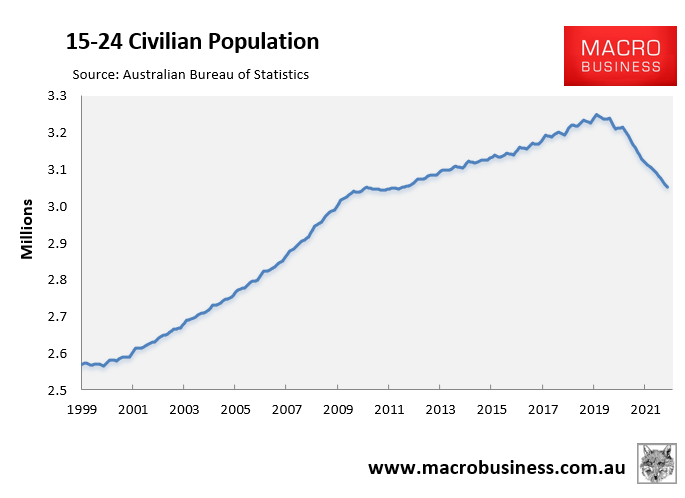
In turn, Australia’s working-aged population has stagnated throughout the pandemic:
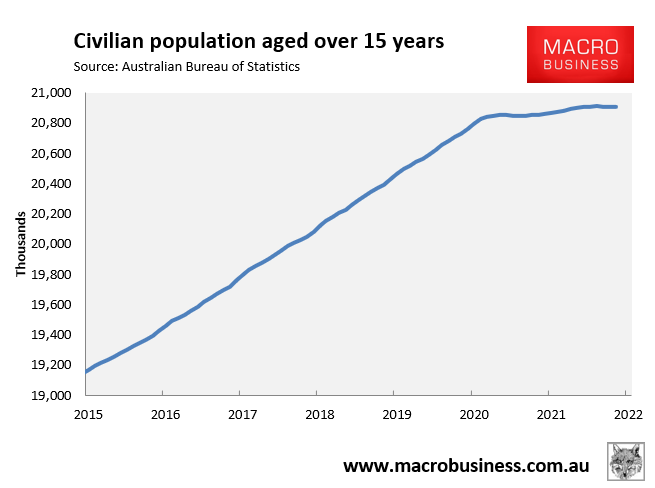
This lack of growth in labour supply has helped to drive the employment-to-population ratio to its highest ever level as well as driven the nation’s unemployment rate to its current 14-year low of 4.2%:
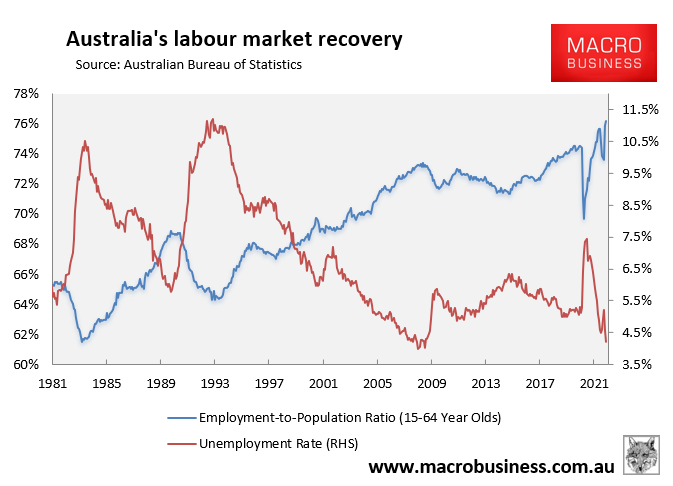
Australia’s youth have also benefited greatly from not having to compete for jobs against international students, with the youth unemployment rate cratering and labour force participation reaching its highest level since 2008:
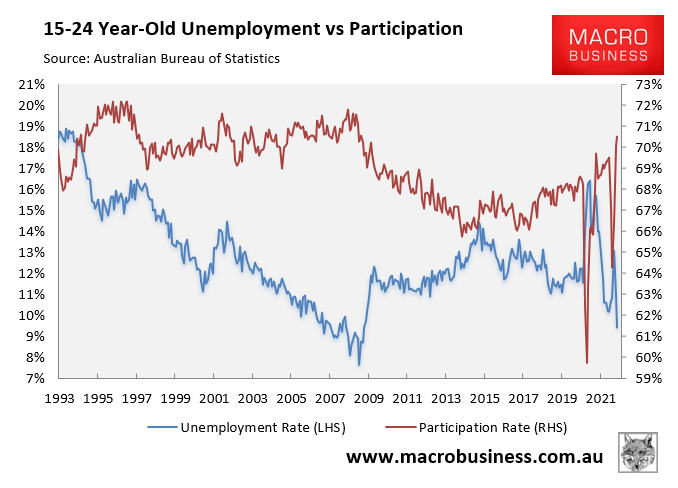
Australia’s underemployment rate has also cratered to its lowest level since 2008, with youth underemployment at a nine year low:
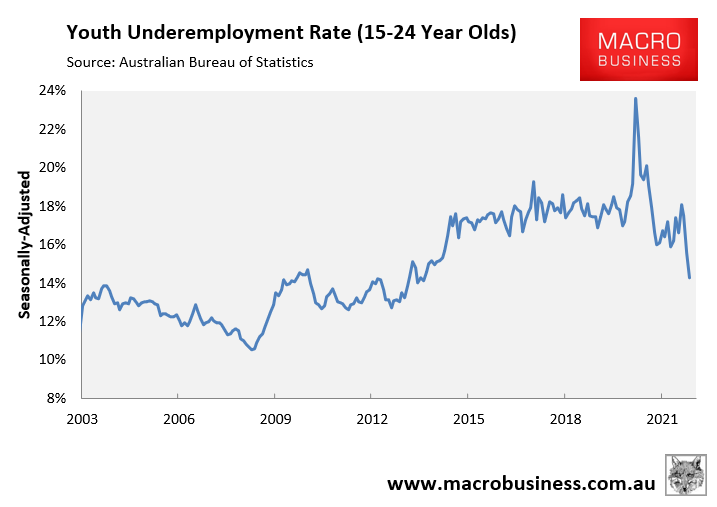
Obviously, rebooting the international student trade and mass immigration, as advocated by the Morrison Government and various industry lobby groups, would increase the supply of labour, reduce worker bargaining power, push-up the unemployment rate, and stifle wage growth. In turn, it would penalise working Australians.
Australia’s concentration of international students was far too high
Australia’s absurd pre-COVID concentration of international students was illustrated clearly by Professor Salvatore Babones’ seminal 2019 study entitled “The China Student Boom and the Risks It Poses to Australian Universities”.
This report showed that Australia’s concentration of international students in 2017 was roughly 2.5 times the United Kingdom’s, three times Canada’s, and six times the United States’:
The broader costs (negative externalities) of Australia’s extreme concentration of international students has been conveniently ignored by Nancy Arthur, including:
- Erosion of entry and teaching standards at universities, as documented in 2019’s Four Corners report and elsewhere.
- Negative impacts on the labour market given students are allowed to work. These students are vulnerable and tend to come here with little money. They are ground zero for wage underpayment and theft, and contribute to Australia’s chronically poor wages growth. They are a key part of Australia’s broader immigration story.
- Erosion of freedom of speech: as witnessed at UQ with the Drew Pavlou affair. We’ve got 13 CCP-run Confucius Institutes operating at Australia’s universities.
International students became Australia’s major funnel to our immigration program. Many come here primarily for work rights and/or permanent residency, rather than to obtain an education. In turn, Australia’s universities basically became ‘middle-men’ to the immigration system, behaving more like migration agents and degree factories to maximise student fees. They lowered entry standards to maximise student numbers. Cheating is rife. There’s immense pressure on staff to pass these students. And the net result is a lower quality system.
When one considers the costs associated with the international student trade, the notion of returning to the pre-COVID system must be rejected.
How to fix the international education system
Australia’s international education system could be improved by targeting a smaller intake of higher quality students via:
- Raising entry standards (particularly English-language proficiency);
- Raising financial requirements needed to enter Australia; and
- Removing the link between studying, work rights and permanent residency.
These reforms would lift student quality, would raise export revenues per student, and would lower enrolment numbers to sensible and sustainable levels that are more in line with international norms.
They would also help to improve teaching standards and the experience for domestic students, which should be our universities’ number one priority.
We must ignore vested interest lobbyists like Nancy Arthur and restore Australia’s universities back to being about ‘higher learning’ rather than ‘higher earning’.

